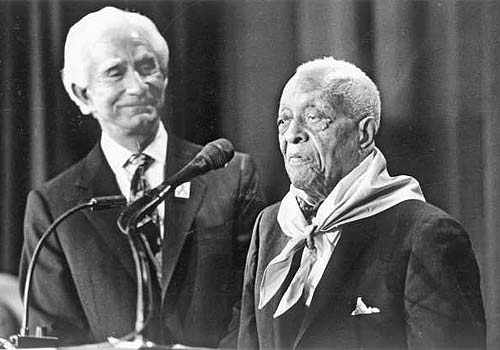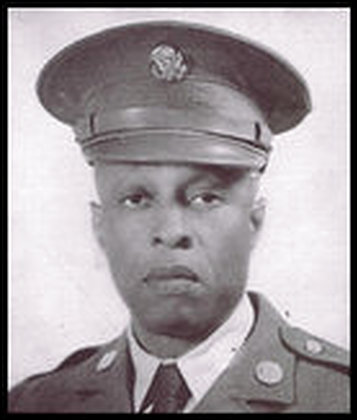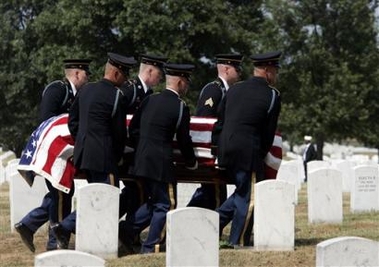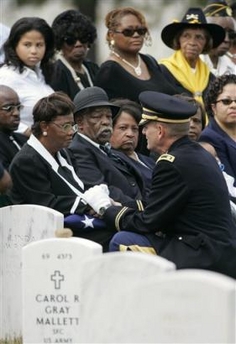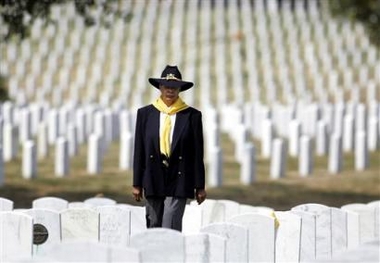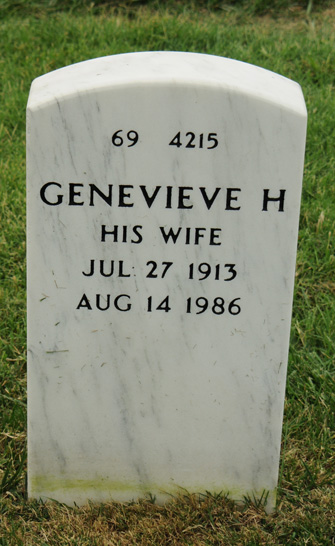The oldest living member of the 10th Calvary Buffalo Soldiers marked his 108th birthday Wednesday with a trip to the State Department.
Retired First Sergeant Mark Matthews met with Secretary of State Colin Powell, a long-time advocate of commemorating the Buffalo Soldiers — black soldiers who served in segregated outfits on the Western frontier in the late 19th and early 20th centuries.
Matthews, born in 1894 in Greenville, Alabama, enlisted at age 16 and served for many years in Arizona and Texas. He patrolled the Mexican border with the 10th Cavalry, which was disbanded in 1949 during the desegregation of the Army after World War II.
In the last years before his retirement in 1949, he trained recruits in horsemanship and helped tend the presidential stable, said William Aleshire, a Bowie, Maryland, city councilman and military historian who accompanied Matthews and family members to the State Department.
Matthews now lives in the District of Columbia with family members.
“He still has a lot of vim and vigor,” Aleshire said.
Powell, the first black to be chairman of the Joint Chiefs of Staff, was among those who campaigned strongly for a monument honoring the Buffalo Soldiers. Powell dedicated the monument in Fort Leavenworth, Kansas, in 1992.
A relative of Matthews, Wayne Curry, executive for Prince George County, Maryland, presented Powell with a portrait of Matthews.
The name Buffalo Soldiers was given to the troopers of the 9th and 10th Cavalry regiments by their adversaries in the Indian wars following the Civil War.
The Indians respected the black soldiers for their courage and fearlessness, qualities they found in the buffalo. They also thought the soldiers’ hair resembled the tuft between the horns of the bison.
In any case, the soldiers wore the nickname with pride.
The name eventually also came to be associated with the all-black 24th and 25th Infantry regiments, which often fought beside the cavalry outfits.
At least 14 Buffalo Soldiers were awarded the Medal of Honor in the years from 1870 and 1890.
All four outfits later distinguished themselves in the Spanish-American War in 1898, and segregated units fought in both world wars and the Korean War.
The career Army man, who retired as a first sergeant in 1949, appears with former Postmaster General Marvin Runyon in 1993. Matthews took part
in the American expedition to capture Pancho Villa in 1916, trained recruits in horsemanship in the 1930s and fought in World War II on Saipan.
Michael King posted a particularly interesting story about First Sergeant Mark Matthews. 1SG Mattews served at Fort Huachuca, patrolled the border with Mexico, trained Cav soldiers, and served the US Army during war time before retiring. This past week First Sergeant Matthews died.
As an ardent consumer of military history, First Sergeant Matthews is a perfect subject. He retired in 1947 – four years before his origianl unit was deactivated – having served in the US Army for 37 years. When he was laid to rest last week, he was 111 and the oldest “Buffalo Soldier.”
Born in 1894 in Alabama, Matthews rode horses from early childhood, delivering the local newspaper on his pony. “I was 16 when I joined the Army to be a soldier,” he recalled. “I had to wait awhile before I could get on duty. But then they shipped me to the West.”
He was stationed at Fort Huachuca, Arizona, which still was using local Indians as guides. “Ilike the Army,” Matthews said. “I learned all the different rules, how to lridwe the different horses, how to jump and how to shoot. There couldn’t hardly anybody beat me shooting. Every time I got in a contest where I shot at a target or something, I usually won.”
Matthews served on the border patrol during the years the cavalry was on the trail of the notorious bandit Pancho Villa. “I never met him,” Matthews said, “but I knew where he was at. I was on the border patrol for a good lilttle while.”
In the ’20s, he helped to train younger cavalry members. “I had a whole troop of my own,” he said. “I trained them how to ride the horses, what to do and what not to do.” And during World War II, when he was already in his late 40s, Matthews saw action on Saipan in the South Pacific. He remembers Tokyo Rose, the radio voice of the anti-American Japanese propaganda, and the snipers who ringed the island. “A soldier I knew — a lieutenant who had been in the Army six years, fighting in Europe — got shot that first doggone day.”
I was born and live in Tucson, Arizona and 1SG Matthews was undoubtedly a part of the amazing history of this area. The history of the 9th and 19th Cavalry is quite amazing in itself.
For over twenty years the 9th and 10th Cavalry Regiments fought campaigns against American Indian tribes on the Western Frontier that ran from Nontana to Texas, New Mexicoa and Arizona. They fought mini battles against some great Indian Chiefs which include Geronimo, Victorian, Nana, and others.
The name of “Buffalo Soldiers” was given to the Black cavalrymen by the Indians of the Plains because they saw a resemblance between the Black man’s hair and the mane of the buffalo. Another reason was, when a buffalo was cornered or wounded, they fought ferociously, showing unusual courage and stamina, a quality the Indians also saw in the fighting spirit of the Black cavalrymen. The buffalo was sacred to the American Indians which they held in high regare; therefore, the Buffalo Soldiers were found worthy of the tribute.
When not fighting with the Indians, the Buffalo Soldiers built forts and roads, located and guarded water water holes, erected telegraph lines, excorted wagon trains and cattle drives, and rode shotgun on stage coaches and routes of mail runs. they also protected settlers from renegade Indians, outlaws and Mexican revolutionaries.
Buffalo Soldiers earned 24 Medals of Honor during the Indian Wars. It is the highest honor that a military man can receive. Some troops of the 9th & 10th Cavalries fought in Cuba on San Juan Hill with Colonel (and later President) Theodore Roosevelt and his Rough Riders. The 10th Cavalry rode with General Hohn J. Pershing during the Punitive Expedition in Mexico in search of Pancho Villa.
For many years the 9th & 10th Cavalry Regiments an the 34th & 25th Infantry Regiments were the only military units that Black men could join. Volunteers had to wait for someone to retire or die to fill the vacancies.
I am in awe of soldiers like 1SG Matthews. I wish him Godspeed and I hope his family understands how much a hero First Sergeant Mark Matthews is.
Sergeant Mark Matthews Dies; at 111, Was Oldest Buffalo Soldier
By Joe Holley
Courtsy of the Washington Post
Tuesday, September 13, 2005
Retired First Sergeant Mark Matthews, 111, one of the last of the nation’s legendary Buffalo Soldiers, died of pneumonia September 6, 2005, at Fox Chase Nursing Home in Washington.
Sergeant Matthews, who also was the oldest Buffalo Soldier, was heir to a proud military heritage that originated with the black soldiers who fought in the Indian wars on the Western frontier. Historians say that the Cheyenne, Kiowa and Apache tribes bestowed the appellation because the soldiers’ black, curly hair reminded them of a buffalo’s mane.
Given Native American reverence for the sturdy animal of the Plains, the soldiers wore the nickname proudly — and with good reason. The Buffalo Soldiers won 20 Medals of Honor, more than any other regiment. They also helped lay hundreds of miles of roads and telegraph lines, protected stagecoaches, were involved in the military actions against the Apache chiefs Victorio and Geronimo and fought bravely in Cuba at the side of Teddy Roosevelt’s Rough Riders during the Spanish-American War.
Sergeant Matthews joined up at the end of the Buffalo Soldiers’ colorful Western exploits. The regiments that made up the Buffalo Soldiers — the 9th and 10th cavalries and 24th and 25th infantries — stayed together for years afterward, however, fighting in World War I and II and Korea. The all-black regiments were disbanded in 1952 after the Army desegregated.
Sergeant Matthews was born August 7, 1894, in Greenville, Alabama, and grew up in Mansfield, Ohio. He rode horses starting when he was a child, delivering newspapers on his pony.
According to stories Sergeant Matthews told friends, family members and at least one military historian, he was 15 when he met members of the Buffalo Soldiers’ 10th Cavalry; they were visiting a Lexington, Kentucky, racetrack where he worked exercising the horses. When the soldiers told him that they rode horseback wherever they went, he decided he had to join up. Although young men had to be 17 to enlist, his boss concocted documents that convinced a Columbus, Ohio, recruiter that he was of age.
“I was 16 when I joined the Army to be a soldier,” he told Parade Magazine in 2003. “I had to wait awhile before I could get on duty. But then they shipped me to the West.”
Fort Huachuca, Ariz., where he was first stationed, was still using local Indians as guides. “I learned all the different rules, how to ride the different horses, how to jump and how to shoot,” he recalled in the 2003 interview. “Every time I got in a contest where I shot at a target or something, I usually won.”
He served along the U.S.-Mexican border as part of General John Joseph “Black Jack” Pershing’s 1916 expedition into Mexico, on the trail of Mexican bandit and revolutionary Pancho Villa. “I never met him,” Sergeant Matthews said in the Parade interview, “but I knew where he was at.”
In 1931, he was assigned to Fort Myer, where he trained recruits in horsemanship, helped tend the presidential stable for Franklin D. Roosevelt and played on the polo team. Ten years later, although he was in his late forties when the United States entered World War II, he saw action on Saipan in the South Pacific.
He retired from the Army in 1949 and became a security guard at the National Institutes of Health in Bethesda. He retired a second time, as chief of guards, in 1970.
In retirement, he liked to fish. He also enjoyed sitting on the front porch and telling tales about the old days out West and the not-quite-so-old days in the Pacific during World War II, often to neighborhood kids who came around and sat at the knee of a man who had experienced an adventure-novel’s worth of stirring chapters in U.S. history.
He spent time with the children, enjoyed looking after them. He took them fishing with him, made sure they got to school, took them in if they needed a place to stay. “They called him Daddy,” daughter Mary Matthews Watson recalled.
He met with President Bill Clinton at the White House, and in 2002 marked his 108th birthday by meeting with Secretary of State Colin Powell, who for many years campaigned for a monument honoring the Buffalo Soldiers. In 1992, Powell, then-chairman of the Joint Chiefs of Staff, dedicated the monument at Fort Leavenworth, Kan., birthplace of one of the regiments.
Believed to be Washington’s oldest man — the District’s Office on Aging lists a woman, Corrine Taylor, as slightly older — he had lived with his daughter in the same Northwest neighborhood for more than half a century. He had been in good health until recently. Before he began to lose his eyesight to glaucoma about 10 years ago, he enjoyed reading his Bible daily. He was a former member and trustee of Trinity AME Zion Church in the District, a member of Prince Hall Masonic Temple and a member of the Washington, D.C., Chapter of the 9th and 10th (Horse) Cavalry Association.
His wife, Genevieve Hill Matthews, died in 1986. They had been married 57 years. A daughter, Shirley Ann Matthews Mills, died in 1988.
In addition to Watson, of Washington, survivors include two other daughters, Gloria J. Matthews, also of Washington, and Barbara Jean Young of Dacula, Ga.; a son, Mark Matthews Jr. of Hyattsville; nine grandchildren; and 17 great-grandchildren.
“I did it all,” Sergeant Matthews told The Washington Post a few years ago. “Yes, I was there.”
Oldest Buffalo Soldier to be buried at Arlington
Cavalryman fought under Pershing and in the South Pacific
From Larry Shaughnessy
CNN Washington Bureau
Saturday, September 17, 2005
BUFFALO SOLDIERS
Activated on July 28, 1866
Formed by black volunteers composed of freed salves, Civil War vets
1869: helped establish Fort Sill, Oklahoma
1880: defeated Chief Victorio’s band of Commanches
1885: defeated Geronimo’s Apaches
1898: accompanied Teddy Roosevelt up San Juan Hill
1913: assisted in the expedition against Pancho Villa
Source: First Squadron, 10th Cavalry
Mark Matthews, the oldest Buffalo Soldier, has died at the age of 111. He’ll be buried Monday at Arlington National Cemetery.
Matthews joined the legendary unit of black cavalry troops in 1910 at the age of 16. He soon found himself serving under General John Joseph “Black Jack” Pershing in the Army’s pursuit of Pancho Villa, the revolutionary from Mexico who was considered a bandit.
Matthews later served in the South Pacific during World War II, rising to the rank of First Sergeant.
The name Buffalo Soldiers was given to the troops of the all-black 9th and 10th Cavalry regiments by their adversaries in the Indian wars of the late 1800s. The name is believed to have originated either because the Indians thought the soldiers’ hair resembled a buffalo’s mane or that the Indians respected the soldiers for their courage and fearlessness, qualities they found in the buffalo.
The soldiers wore the nickname with pride. And they earned their reputation. More than 20 Buffalo Soldiers went on to receive the Medal of Honor, the military’s highest award for valor. No other unit has won more.
After retiring from the Army shortly before it was formally desegregated by President Truman, Matthews had a long career as a security guard at the National Institutes of Health.
In his later years Matthews became a symbol of the Buffalo Soldiers. In 1994 he was invited to the White House to meet President Clinton.
And in 2002 he visited the State Department to meet Secretary of State Colin Powell, the first African-American to become chairman of the Joint Chiefs of Staff. Powell had been instrumental in getting a monument to the Buffalo Soldiers built at Fort Leavenworth, Kansas, in 1992.
According to the Washington Post, which first reported Matthews death, he was until his passing the oldest man in Washington, D.C. He died September 6, 2005, of pneumonia at a D.C. nursing home.
A funeral service will be at Trinity AME Zion Church in Washington.
On Tuesday, September 6, 2005, 1st Sgt. Mark Matthews, retired 111, died at the Fox Chase Rehabilitation Center in Silver Spring, Maryland. He is survived by four children Mary M. Watson of Washington, D.C., Mark Matthews, Jr. of Hyattsville, Maryland, Gloria J. Matthews of Washington, D.C. and Barbara J. Young of Dacula, Georgia, 12 grandchildren and 17 great-grandchildren. He is also survived by a host of other relatives and friends.
The family will receive friends from 4 to 7 p.m. on Sunday, September 18, 2005 at Trinity AME Zion Church, 3505 16th St. N.W., Washington, D.C. Funeral services on Monday, September 19, 2005 at 10 a.m. at Trinity AME Zion Church. Rev. William E. Kelly, officiating. Interment Arlington National Cemetery. Services by R.N. HORTON.
Buffalo Soldier a Patriot to the End
Oldest Among Black Army Regiment Laid to Rest At Arlington Cemetery
By Avis Thomas-Lester and Hamil R. Harris
Courtesy of the Washington Post
Tuesday, September 20, 2005
He was 111 when he died last week, believed to be the oldest of the Buffalo Soldiers — the black Army men on horseback who helped settle the West and fought abroad even as they were denied personal freedoms at home.
Mark Matthews was born in 1894, when Grover Cleveland was president, 28 years after the federal government had formed six regiments of black soldiers, largely to acknowledge the contribution they made during the Civil War.
As he was laid to rest yesterday with full military honors at Arlington National Cemetery, First Sergeant Matthews was remembered by family, friends and military colleagues as a dedicated father, a committed friend and a patriot, the elder statesman of a group that opened the door for blacks in military service long before the Tuskegee Airmen took to the skies.
“He was a piece of living history,” said Mary E. Brown, 85, vice president of the Baltimore chapter of Buffalo Soldiers Inc. and a close friend. She told a story about taking a dark blue cavalry hat and bright yellow scarf to the aging soldier last month on his birthday. “When I placed the hat on his head, he said, ‘This hat is too small.’ He was spit and polish until the day he died.”
More than 1,000 people attended two wakes for Matthews at Trinity AME Church in Northwest yesterday and Sunday. And more than 500 were present for his burial yesterday afternoon in a vault above his wife, Genevieve, who died in 1986.
Mary Matthews Watson, his daughter and caretaker, was given a folded U.S. flag in honor of her father, who was also the oldest man on record in the District. He died of pneumonia September 6, 2005, at a Washington nursing home.
“It is really true that old soldiers never die — they just fade away,” Watson said after the service. “When they presented me the flag, I felt not only for my father, but for all the Buffalo Soldiers and the other African American soldiers who were such great heroes and such great Americans.”
No one knows how many Buffalo Soldiers are left. Their numbers have dwindled as years, then decades, and now more than a century have passed since the group’s inception in 1866, the year after the Civil War ended.
They were known then simply as the “colored soldiers,” about 5,000 men who enlisted in the 9th and 10th cavalries and the 38th, 39th, 40th and 41st infantry units. Some signed on for the chance to see more than the fields they had worked as slaves, others to take a part in the change they knew was coming.
They worked long hours laying roads and telegraph lines, escorting wagon trains and guarding stagecoaches. They fought against Geronimo in Arizona and against Spain in Cuba. Matthews was among those who helped Gen. John J. “Black Jack” Pershing pursue Pancho Villa in Mexico. Later, he trained recruits in horsemanship at Fort Myer and fought in the South Pacific in World War II.
Coley Davis, 83, a friend from Livingston Manor, NEw York, said the men wore the name Buffalo Soldiers with pride. The nickname had been bestowed by Indians, who said their curly hair reminded them of a buffalo’s mane. The name was also a term of respect, soldiers said.
“Like the buffalo, they fought with strength and power when confronted,” said William Aleshire of Bowie, the group’s spokesman and author of a book on the black soldiers.
Davis recalled the life of the horse soldiers in the cavalry, who patrolled the West on horseback until the horse units were mechanized in 1944. His shins still bear the scars from the tight riding boots the soldiers wore.
He recalled their struggles to be treated fairly, despite their heroic exploits.
“I remember at the pool at Fort Meade, they used to let the white boys swim on Monday, Tuesday and Wednesday, then we could swim on Thursday. Then they drained the pool and scrubbed it so the white boys could have a clean pool again on Monday,” he recalled.
Yesterday’s ceremony for Matthews included a procession, led by members of the Buffalo Soldiers Motorcycle Club, from the church to the cemetery, where black soldiers were once buried in a segregated area. The motorcyclists wore the group’s trademark blue cavalry hat and brown leather jacket.
As they remembered Matthews, loved ones fretted that the history of the Buffalo Soldiers might die with them.
“African Americans have [served] with honor and distinction for decades, lest we forget,” said Loretta Clarke, 70, a member of the D.C. Chapter of the 9th and 10th Horse Cavalry who stood proudly at attention during the funeral in her dress blue uniform and cavalry hat.
Added Davis: “I was the first black soldier to guard the Tomb of the Unknown Soldier. You’d be surprised about how many people never heard of the Buffalo Soldiers.”
But others said their contributions will always be a part of U.S. history, pointing to a monument that was dedicated to them at Fort Leavenworth, Kan., in 1992 and a postage stamp issued in their honor in 1994.
“We came down here because Trooper Matthews was one of our own. He was a great man,” said Herb Dorsey, of Fort Dix, New Jersey, who led the motorcycle procession.
“He was a Buffalo Soldier ,” he said, standing taller.
The casket of 111 year-old First Sergeant Mark Matthews, one the the last members of the Buffalo Soldiers, is carried to its final resting place at Arlington National Cemetery on Monday, September 19, 2005
Arlington National Cemetery Chaplain Kenneth Kerr, right, hands a flag to the daughter
of 111 year-old 1st Sgt. Mark Matthews, on Monday, September 19, 2005
Loretta Clarke, of Washington, stands at Arlington National Cemetery before the funeral of 111 year-old First Sergeant Mark Matthews, one the last members of the Buffalo Soldiers, on Monday, September 19, 2005. Clarke is dressed in the period dress uniforms of the Buffalo Soldiers
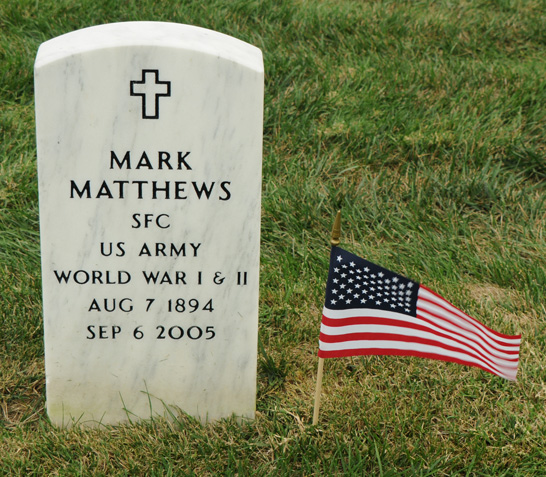
MATTHEWS, MARK
- SFC US ARMY
- WORLD WAR I, WORLD WAR II
- DATE OF BIRTH: 08/07/1894
- DATE OF DEATH: 09/06/2005
- BURIED AT: SECTION 69 SITE 4215
ARLINGTON NATIONAL CEMETERY
Michael Robert Patterson was born in Arlington and is the son of a former officer of the US Army. So it was no wonder that sooner or later his interests drew him to American history and especially to American military history. Many of his articles can be found on renowned portals like the New York Times, Washingtonpost or Wikipedia.
Reviewed by: Michael Howard

